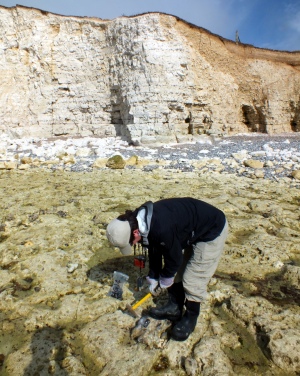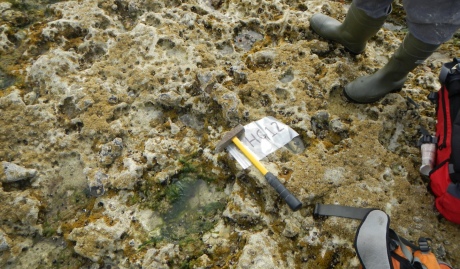

The erosion rates of cliffs along the Sussex coast have rapidly sped up in the last 200 years, a new study has found.
The research shows that the erosion rates along Beachy Head and Seaford Head in Sussex had remained relatively stable, at around two to six centimetres each year, for thousands of years. However, around 200 to 600 years ago the rates rapidly accelerated, increasing to between 22 and 32 centimetres each year.

Dr Rood taking rock samples
The authors suggest that rising sea levels and increasingly severe storms have rapidly eroded the Beachy Head and Seaford Head shorelines. The loss of beach means that the cliffs are exposed to the eroding wave action forces, which is causing them to collapse into the sea. The researchers suggest this erosion process is probably happening along other coastlines in the UK and elsewhere around the world, with implications for how coasts will respond to climate change and what we can do to manage the impact on important coastal infrastructure.
Dr Dylan Rood, co-author from the Department of Earth Science and Engineering at Imperial College London, said: "The coast is clearly eroding, and Britain has retreated fast. Our study on British coasts leaves no question that coastal cliff retreat accelerated in the recent past. A nearly ten-fold increase in retreat rates over a very short timescale, in geological terms, is remarkable. The UK cannot leave the issue of cliff erosion unresolved in the face of a warming world and rising sea levels. Cliff erosion is irreversible; once the cliffs retreat, they are gone for good."
Cliff erosion is irreversible; once the cliffs retreat, they are gone for good.
– Dr Dylan Rood
Department of Earth Science and Engineering
The scientists used a process called cosmogenic dating to learn how the chalk cliffs at Beachy Head and Seaford Head have eroded. Cosmogenic dating allows scientists to analyse the build-up of a rare isotope of beryllium (beryllium-10). This isotope is created when cosmic radiation reacts with oxygen atoms in the exposed flint rock, so by measuring its accumulation, it acts as a kind of ‘rock clock’ to show the rate of rock erosion.
Since the rate of accumulation has previously been relatively constant, measuring rock samples from across the shore platforms allowed researchers to build a record of how coastal erosion has proceeded over the last 7000 years or so.
Dr Rood added: "Cosmogenic isotopes including beryllium-10 are advancing the science of retreating coastlines in Great Britain and worldwide. These new tools provide a rare insight into how dramatically environmental change and human impact affected sensitive coastal landscapes. We still need to better understand how other rocky coastlines have responded in the past, and cosmogenic isotopes are the key to unlocking this mystery."

Eroded chalk with pieces of flint (the darker material), which the researchers analysed for levels of beryllium-10
The researchers now hope to use their observations to create a more accurate predictive model of how climate change will affect coastal erosion in the future, which could help authorities make more informed decisions about coastal management.
The research was led by the University of Glasgow in collaboration with Imperial College London, the University of Colorado, the British Geological Survey, and theEnvironment Agency. The team’s paper, titled ‘Recent acceleration in coastal cliff retreat rates on the south coast of Great Britain’, by Martin D. Hurst, Dylan H. Rood, Michael A. Ellis, Robert S. Andersond, and Uwe Dornbusch, was published in the Proceedings of the National Academy of Sciences on 7 November 2016.
Article text (excluding photos or graphics) available under an Attribution-NonCommercial-ShareAlike Creative Commons license.
Photos and graphics subject to third party copyright used with permission or © Imperial College London.
Reporter
Caroline Brogan
Communications Division

Contact details
Tel: +44 (0)20 7594 3415
Email: caroline.brogan@imperial.ac.uk
Show all stories by this author
Leave a comment
Your comment may be published, displaying your name as you provide it, unless you request otherwise. Your contact details will never be published.




Comments
Comments are loading...